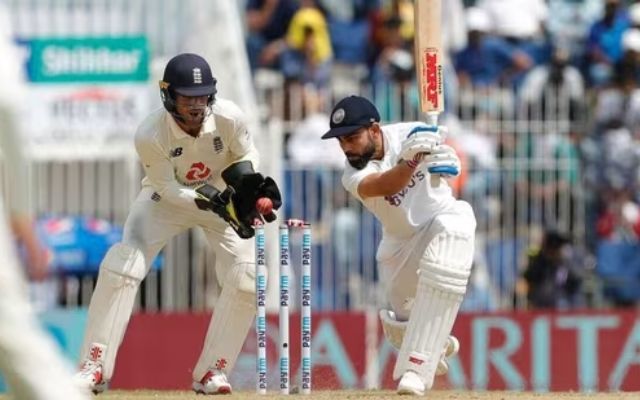
In recent times, Team India’s batsmen have been seen struggling against the spinners.
The Indian team won the five-match Test series against England by 4-1. By winning this Test series, the Indian team strengthened its claim for the first place in the World Test Championship. After playing the World Test Championship final twice in a row, Team India has staked its claim to play the Test Championship final this time too. The Indian team may have won this series by 4-1, but in this Test series and the Test series played at home in the last few years, one shortcoming of the Indian team has been sharply exposed.
Such a deficiency has been exposed in which the Indian team once had expertise. In the last few years, the Indian team has proved to be poor in playing spin. The Indian team is now facing problems in playing spin in India itself. Whereas earlier this was the mantra of victory for the Indian team. He used to prepare spin tracks against foreign teams and defeat them. Now it has happened that when foreign teams tour India, they trouble the Indian team by including two-three good spinners. After coming here, even their average bowlers become great bowlers.
Whereas in the past, Indian teams have batted brilliantly on spin-friendly pitches in domestic and subcontinental conditions. However, at present the Indian team seems to be struggling completely in facing spin. The bowling of the Indian team has been excellent in India since the beginning. Now it has become stronger while there has been a decline in the art of playing spin in batting.
![]()
The Indian team which once used to trouble the opponents with its spin bowling in the 70s. At the same time, in today’s time our batsmen get troubled. In the 70s, there was the famous quartet of Eerappalli Prasanna, BS Chandrasekhar, Venkat Raghavan and Bishan Singh Bedi, who used to dominate against foreign teams on Indian pitches. These people had created so much fear in the minds of the foreign batsmen that the teams touring India started practicing spin a month in advance, but still their quartet did not give the batsmen a chance to do anything special.
After that, from 1980 to 2010, the Indian team had such batsmen who left their mark not only in India but also abroad. There were some batsmen who were adept at playing spin at home and were also adept at playing swing and pace if they toured abroad. During that time, many such great spinners also came to India, who left their mark in the whole world but bowed down before the Indian batsmen. Many such greats came from Shane Warne to Muttiah Muralitharan, but Indian batsmen faced those great spinners boldly and also showed the world the art of playing spin.
What happened in the recent past that what was our strength has become our weakness. Indian players who have grown up playing on spin-friendly pitches are not able to face spin effectively today. Where the wicket starts deteriorating, the batsmen of the Indian team do not find their feet on the crease. With time, the technique that Indian players should have to play spin is gradually deteriorating. Now, as much difficulty as the visiting team finds in playing spin, the Indian team also finds it difficult in facing spin.
Why are batsmen struggling against spin?
![]()
Spinners get a lot of advantage on Indian pitches. Here the spinners get a lot of help from the wicket, due to which spinners prove to be more effective in India. As the wicket starts breaking, the spinners start getting more bounce with the turn. If the bowler knows how to drift the ball, then the batsmen find it more difficult to face such a bowler. Because such bowlers are able to take maximum advantage of the pitch and trouble the batsmen a lot.
The wickets in India are dry and slow and the ball also turns quickly with uneven bounce. To play on such wickets, batsmen need to show more caution. For which the batsmen should know the art of playing spin very well. Due to difficulty in playing spin, batsmen are unable to rotate the strike. Due to which the spinners dominate the batsmen. When a batsman plays 6 balls of an over himself, his chances of getting out are also higher. That’s why it was said that you keep rotating the strike so that it causes trouble to the bowler and not the batsman.
In the last 10-15 years, foreign spinners who have debuted in India have troubled the Indian batsmen. In 2008, when the Australian team came to tour India, Jason Krejza took 8 wickets in the first innings and 4 wickets in the second innings of his debut match. After that the foreign spinners started dominating the Indian batsmen. If we talk about Australia’s Steve O’Coffey, he took 6-6 wickets in both the innings while touring India in 2021. At the same time, Matt Kuhneman had told the Indian team by taking 5 wickets that the art of playing spin is no longer that good.
![]()
After that, New Zealand’s Ajaz Patel also achieved the feat of taking 10 wickets in an innings against India in India itself. He took a total of 14 wickets in that match. Whereas Todd Murphy, making his debut in 2023, took 5 wickets in an innings. Now in the very first match of the five-match Test series played against England, Tom Hartley made his debut and took 7 wickets in an innings. After that, Shoaib Bashir took five wickets each in the fourth and fifth matches of this test series. England’s Tom Hartley took a total of 22 wickets in this series. In these 10-15 years, foreign spinners have come to India and troubled the Indian team.
Batsmen are unable to work on technique
![]()
Now cricket is played continuously all over the world throughout the year. In such a situation, international cricketers get very little opportunity to work on their shortcomings. Now the Indian cricketers who start playing international cricket do not participate in domestic cricket. Due to which they get less opportunity to play domestic bowlers or spinners. Apart from this, now the batsmen are seen less with the bowler and more with the bowling machine. Batsmen practice for hours with the bowling machine. At the same time, due to continuous cricket, in limited overs, batsmen adopt a more attacking approach towards spinners and keep trying to score runs. Due to field restrictions, the shortcomings of the batsmen are not revealed. As soon as these batsmen play Test cricket, their shortcomings become clearly visible.
Bowlers also do not practice as much as before. To keep themselves fit in the three formats, bowlers also spend less time in the nets. For whatever reason, batsmen do not know much about their shortcomings. Due to continuous matches, bowlers now mostly focus on their fitness. So that he can play more matches. For this reason, now most of the batsmen are seen practicing only by net bowlers.
Spinners are no longer as effective in domestic cricket
![]()
Now the thing is that now there are not enough good spinners left in domestic cricket who can trouble the batsmen much. Earlier in domestic cricket there used to be more than one spinner. Who used to give importance to international cricket as well as domestic cricket, but now it is not so at all. Now, due to continuous matches, international cricketers are not able to participate in the domestic ones due to which now the batsmen do not get quality spinners. For this reason too, spinners do not prove to be that effective in domestic cricket. Due to the absence of good spinners, the shortcomings of the batsmen are not visible.
What is the best technique to play spin…
![]()
The best way to play spin is to keep your feet moving. You should use frontfoot and backfoot properly. Some batsmen play out to reduce turn and some batsmen like to play after the ball has turned. If you play such spin then you will get success. If you get stuck against the spinner then the bowler will definitely get you out. Apart from this, your hands should be soft so that the ball should not go near the fielders nearby. In Test cricket, you can face good spinners by playing spin in this manner.





